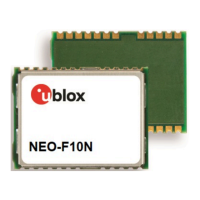NEO-F10N-Integration manual
4 Hardware integration
This section explains how the receiver can be integrated into an application design.
4.1 Power supply
The NEO-F10N has the following power supply pins: VCC and V_BCKP.
A power supply at VCC must be present for normal operation. A supply at V_BCKP is optional. If
present, it enables the hardware backup mode when the VCC supply is off.
Refer to the NEO-F10N Data sheet [1] for absolute maximum ratings, operating conditions, and
power requirements.
4.1.1 VCC
VCC provides power to the core and RF domains. Consequently, it always needs to be supplied to
start up the receiver or for operation in continuous mode. The VCC pin supplies power to the core
via an internal DCDC converter for efficient power consumption. A filtered VCC supply is available
on the VCC_RF module pin.
VCC also supplies all the digital IOs, clock, and the backup domain. The current drawn at VCC
depends on the activity and loading of the PIOs and the main oscillator.
Do not add series resistance greater than 0.2 Ω on the supply line to avoid voltage ripple due to
the dynamic current conditions.
The output voltage at the VCC_RF pin is derived from the VCC supply, and consequently not
available if the VCC supply is removed.
4.1.2 V_BCKP
Power supply at V_BCKP is optional. If the power supply at VCC is interrupted, but the V_BCKP pin is
supplied, the receiver enters the hardware backup mode. In this mode, the RTC time and the GNSS
orbit data in the BBR are maintained. Valid time and GNSS orbit data at startup improves positioning
performance by enabling hot starts, warm starts, and AssistNow Autonomous. This ensures faster
TTFF when VCC is supplied again. To make these features available, connect an independent power
supply to V_BCKP to ensure backup domain supply when VCC is not supplied.
Designs using an external battery as a power source at the V_BCKP pin must consider the battery
capacity. The GNSS satellite ephemeris data is typically valid for up to 4 hours for hot starts, and up
to a few days for warm starts and AssistNow (Offline and Autonomous).
Avoid high resistance on the V_BCKP line. During the switch to V_BCKP supply, a short current
adjustment peak may cause a high voltage drop at the pin.
If the hardware backup mode is not used, leave the V_BCKP pin open.
4.2 RF front-end
GNSS receivers operate with very low signal levels, ranging from –130 dBm to approximately –167
dBm. This alone is a challenge for the GNSS application design. Out-of-band sources of interference
such as GSM, CDMA, WCDMA, LTE, Wi-Fi, or Bluetooth wireless systems with a much higher signal
level require additional specific measures. The goal of the RF front-end design is to receive the in-
band signal with minimum loss and added noise while suppressing the out-of-band interference.
UBXDOC-963802114-12193 - R02
4 Hardware integration Page 21 of 42
C1-Public

